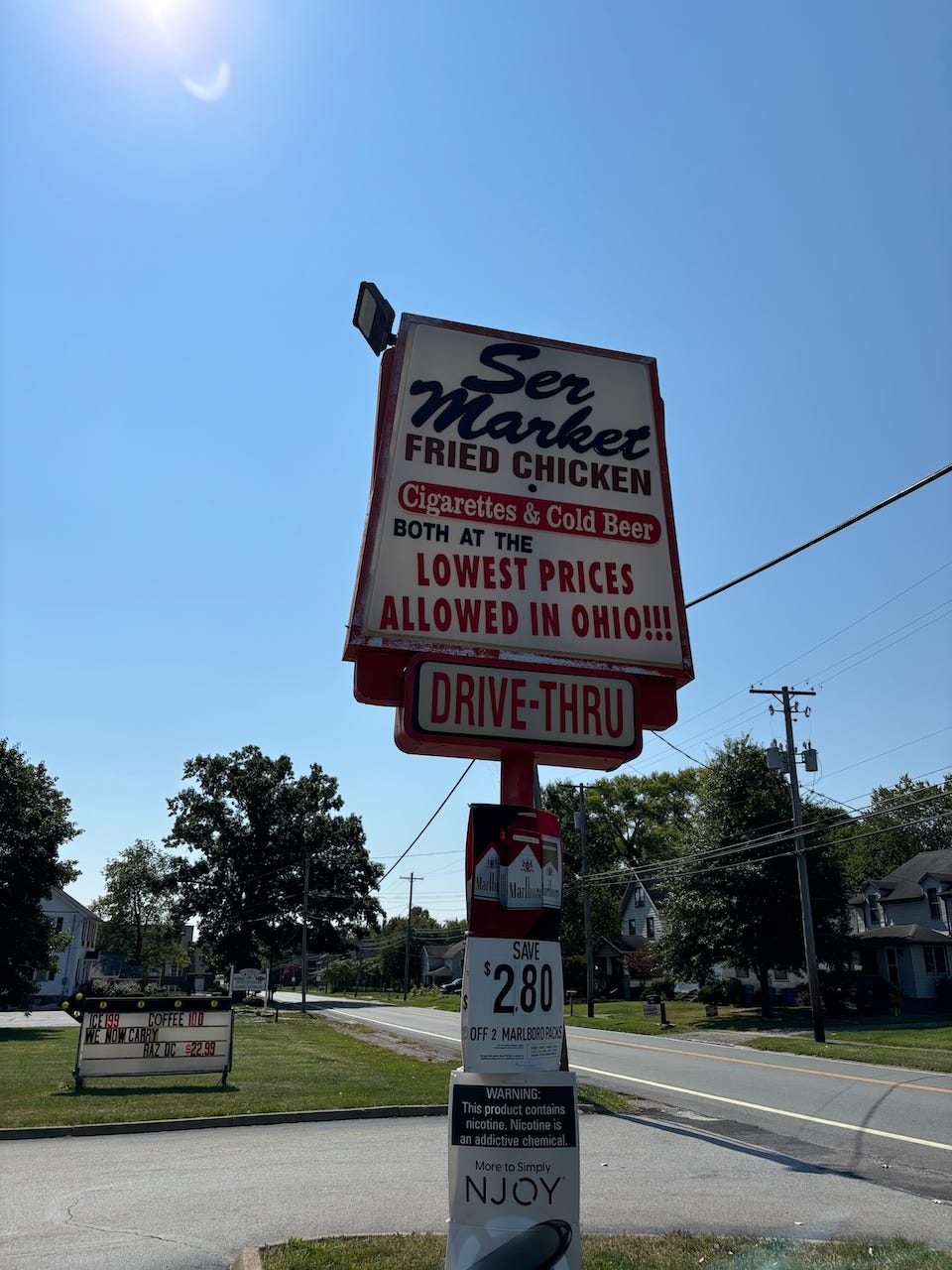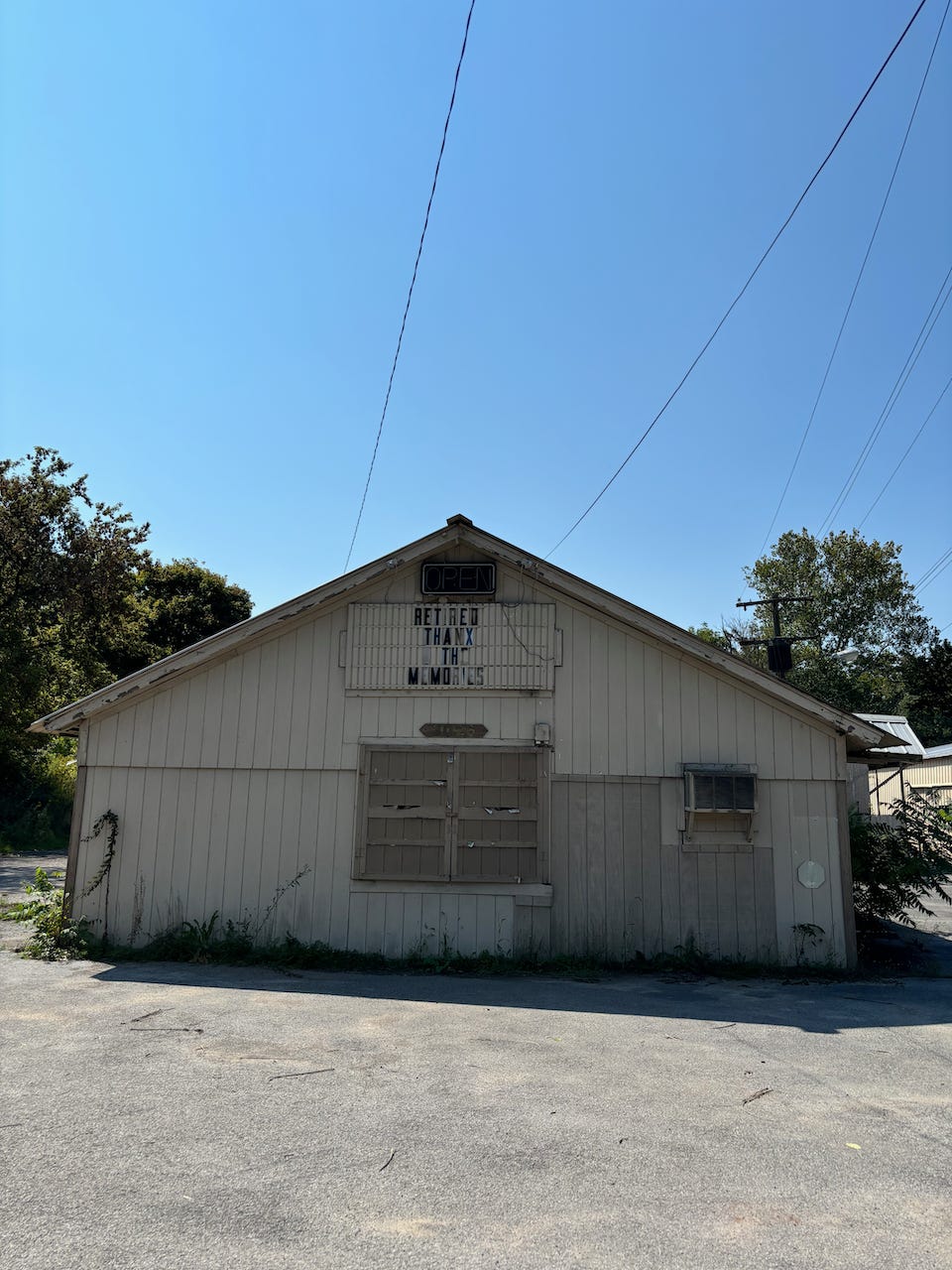YOUNGSTOWN, Ohio — Check your profession at the door.
That’s what John, the animated owner-operator of the Royal Oaks, tells people who come to his bar. After all, he proclaims proudly, “I’ve had millionaires sit next to crackheads.” The Oaks is a proper dive: façade half-caked in ivy, wooden fixtures dominant in the interior, a crowd preoccupied solely with good old-fashioned banter. And it’s where I met locals in Youngstown, a place where pretentiousness goes to die.
This city, once America’s steel capital, has lost 100,000 people in 100 years; I thought it’d be fitting to start my Midwestern road trip in a quintessentially Rust Belt locale. Indeed, the visuals of manual labor are inescapable here. Streets are dotted with metalworking operations, repair shops, purveyors of farming equipment; signage is bold, usually in capital letters, bordering on garish — no minimalist, Instagrammable logos, no funky brand names crafted to vaguely resemble foreign languages. I couldn’t resist pulling over into vacant dust-and-pebble parking lots to photograph some of the businesses.
Black Monday — the day Youngstown Sheet & Tube shuttered in 1977, which cascaded into the closures of four more major employers — is the elephant in the room. At the city’s steel museum, the easygoing curator recalled the events solemnly; locals panicked and protested to no avail, as if witnessing a slow-motion trainwreck.1 A regular at the Oaks told me he’d set his sights on working at Sheet & Tube as a sophomore, only for its demise to force him to start a career in nearby Warren. Precarity eventually returned: that plant closed in his 19th year working there, and he transferred to the area’s ill-fated GM facility, where the last car rolled off the assembly line five years ago. Today, he’s a maintenance man for the county housing authority, trying to make it to retirement and put three kids through college. He spoke with a matter-of-fact resoluteness that signaled he knows things aren’t going to get easier.
All this makes for an interesting strain of people. Despite their hardscrabble appearance — the city has no shortage of broad shoulders — many Youngstown diehards evince an instinctive humility brought on by how much they’ve collectively lost. They’re quite blunt, which made sense to me; who has the capacity for performative socializing when times are tough?2 A Warren local explained that one of his favorite parts of living in the Mahoning Valley is the lack of keeping up with the Joneses.
So what brings people together? On Friday night I had a top 40 radio station on when the broadcast, without warning, cut straight to a high school football pregame show, complete with an announcer dramatically proclaiming the season was likely lost for the loser of the upcoming game. In western Ohio, I heard about a dominant local coach who’s won 10 state titles in the last 13 years. When they’re making a deep run, the joke is that the last person in town turns the lights out; everyone leaves temporarily to support the team. I commiserated with one bargoer over his broken four-leg parlay, got conversation going by asking about the distribution of Browns and Bengals fans. The lesson: no matter who you are, you can break the ice with football talk.3
The night before I set off from home, I felt a few pangs of guilt. This wasn’t about the Midwest; it was about not wanting the robust social circle I’ve cultivated at home to atrophy. But it took all of two conversations to remind me why I wanted to taste impermanence again. Sometimes in high school I’d open Google Maps, plop myself down in a random place, click through a neighborhood’s worth of Street View images, and strain to imagine what life was like there. Now I’m doing the same thing in real life, only with places I already find fascinating! It’s thrilling to be completely immersed in novelty.
After leaving northeast Ohio, I stayed two nights in the state’s much more German and agriculture-oriented western part. My hotel was in Wapakoneta, a sleepy small city that, at 10,000 people, is still the largest in its county. Wapak, as it’s almost always called, is out of the way enough that a pack of curious 13-year-old boys stopped me on the street to say hi.
Twice I stayed almost till closing time swapping stories with bar owners: once at the Oaks, then at Meyer’s, nestled in a village of just over 1,000. Bob, the affable proprietor who bought the place in 1979, reminisced about the debauchery of the 80s (“beach parties” where he trucked in sand; hundreds of youth cramming inside to see local bands). “There aren’t as many characters these days,” he reflected — likely a consequence of fewer people traveling from out of town. I chatted with him and his wife for hours about the worst and best years for local crops, both our families’ histories, and memories from their own vacations. We never would have otherwise interacted in life, yet we couldn’t have enjoyed learning about each other more. I hope I was a good enough character for a night.
Fairs are a big deal - highway signs point to fairgrounds in nearly every county. Sadly, I just missed the Canfield Fair, the biggest in all of Ohio. But I was still able to get a small taste of the fair. A local tipped me off to a concession stand that travels to various fairs in the area, but also just sets up shop year-round!
Road work is far more common than back home. The amount of work zones, mowing, and repaving going on is insane. Maybe it’s correlated with the much higher number of giant trucks on the road?
The Italian mob must have truly controlled Youngstown back in the day. Almost every older adult I spoke to brought it up!
I continue to experience, among strangers, a high baseline willingness to talk. At this point, I doubt that will change. People are cool!
The conversations I’m having are a refreshing change of pace in many ways but chief among them is that not one person has mentioned AI yet.
The older men were more affable, and many of the younger people I talked to had a quiet, guarded vibe.
Youngstown’s food culture is very distinct. They have a unique pizza style and a unique wedding tradition (the cookie table!)

The beauty of meeting people in quieter areas is that nearly every business is fair game — you can walk inside, chat up the workers (and/or the owners) and they’re willing to talk about non-work things in a heartbeat. Without a steady flow of customers, there’s no pressure to leave or consume. These kinds of interactions are virtually impossible in big cities.
The best thing I ate: blueberry iced donuts from Canfield’s White House Fruit Farm, which a Canfield native tipped me off to!
Honorable mention goes to the meal I had at Kewpee Hamburgers, a century-old fast-food chain that once had 400 locations but is down to five now, three of which are in Lima, Ohio:
When I parallel parked in downtown Columbiana, an amused man passing by complimented me on my work. If you were raised near Boston, don’t take this skill for granted.

There was one upside to the closures. A man I chatted up while waiting for pizza told me his grandmother, who lived close to the mills, wiped her porch daily of the black ash coating that descended upon it.
I got hand-cut French fries for $3 and personal pizzas for $5, and everyone informed me prices have skyrocketed recently.
I can’t help but wonder if we’re losing this a bit in urban enclaves with transplant majorities.












